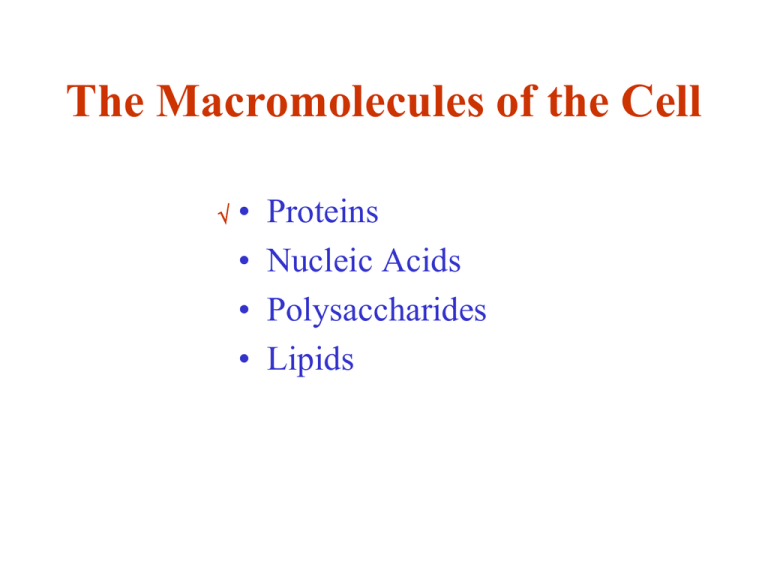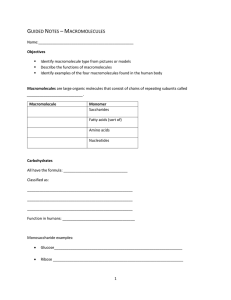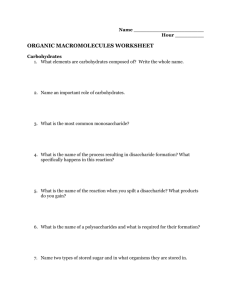The Macromolecules of the Cell • Proteins • Nucleic Acids • Polysaccharides
advertisement

The Macromolecules of the Cell • • • • Proteins Nucleic Acids Polysaccharides Lipids Proteins • The monomers are amino acids • The polymers are polypeptides and proteins • Several kinds of bonds and interactions are important in protein folding and stability • Protein structure depends on amino acid sequence and interaction Several kinds of bonds and interactions are important in protein folding and stability • • • • • Disulfide bond Hydrogen bond Ionic bonds Van der Waals interactions (force) Hydrophobic interaction Primary (1°) structure • Specific linear sequence of amino acids in chain; all levels of structure are ultimately determined by the primary level – Amino acid sequence contains mostinformation needed to specify protein 3D shape & thus its function; changes in sequence resulting from mutation may not be readily tolerated – first was protein hormone insulin determined by Sanger & coworkers, Cambridge, early 1950s Secondary (2°) structure • Form hydrogen bond between imino group (-NH-: 亞硝酸胺) and carbonyl group (-CO-) • α-helix - backbone assumes form of cylindrical, twisting spiral; backbone inside helix, R groups project outwards – Seen in X-ray diffraction patterns of actual proteins in 1950s • β-pleated sheet- consists of several polypeptide segments lying side-by-side; the backbone of each segment of polypeptide adopts a folded or pleated conformation Tertiary Structure • Tertiary (3°) structure is the conformation of entire protein; results from (intramolecular) noncovalent interactions between R groups – X-ray crystallography – NMR spectroscopy– 3D structure of small proteins (<30 kDa) – Most proteins have both α-helix & β-pleated sheet; triosephosphate isomerase mostly β -sheet • Fibrous proteins – Collagens & elastins of connective tissue, keratins (hair, skin, fingernails), silk • Globular proteins– most proteins in cell – Myoglobin - storage site for O2 in muscle tissue Quaternary Structure • Quaternary (4°) structure is the linking of polypeptide chains to form multisubunit functional protein via intermolecular R group interactions • May be linked by disulfide bonds, but more often noncovalent bonds (hydrophobic, H bonds, etc.) like hydrophobic patches on complementary surfaces of neighboring polypeptides • Chains may be identical or nonidentical – Protein composed of 2 identical subunits homodimer – Protein composed of 2 nonidentical subunits heterodimer The Macromolecules of the Cell • • • • Proteins Nucleic Acids Polysaccharides Lipids The Macromolecules of the Cell • Proteins • Nucleic Acids • Polysaccharides (Carbohydrates) • Lipids Carbohydrates • Carbohydrates comprise a group of substances, including simple sugars (monosaccharides) & larger molecules made from them – Serve primarily as chemical energy storehouse & durable building material for biological construction – Most have general formula (CH2O)n • Important ones in cell metabolism have from 3 to 7 carbons (n = 3 - 7) • Trioses, tetroses, pentoses, hexoses, & heptoses - 3, 4, 5, 6, & 7 carbons, respectively The Macromolecules of the Cell • • • • Proteins Nucleic Acids Polysaccharides Lipids Lipids • Composed principally of C, H & O - not macromolecules, but aggregate to form large complexes • Triglyceride (neutral lipid, fats, triacylglycerol) - serves as lipid storage form for fuel (stored in adipocytes) • Fatty acids - long, unbranched hydrocarbon chains with single carboxyl group at one end • Sterols and steroids – complex & characteristic 4 ringed hydrocarbon structures (4 joined rings differ in numbers & positions of double bonds & functional groups) • Phospholipids (phosphoglyceride, diacylglycerol) glycerol + 2 fatty acids + phosphate group on third hydroxyl (often an amino group as well); highly charged at physiological pH; amphipathic Lipids • Fatty acids are the building blocks of several classes of lipids – Saturated and unsaturated fatty acids • Triacylglycerols are storage lipids • Phospholipids are important in membrane structure • Glycolipids are specialized membrane components • Steroids are lipids with variety of functions





